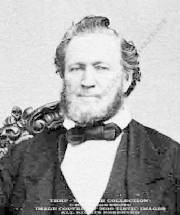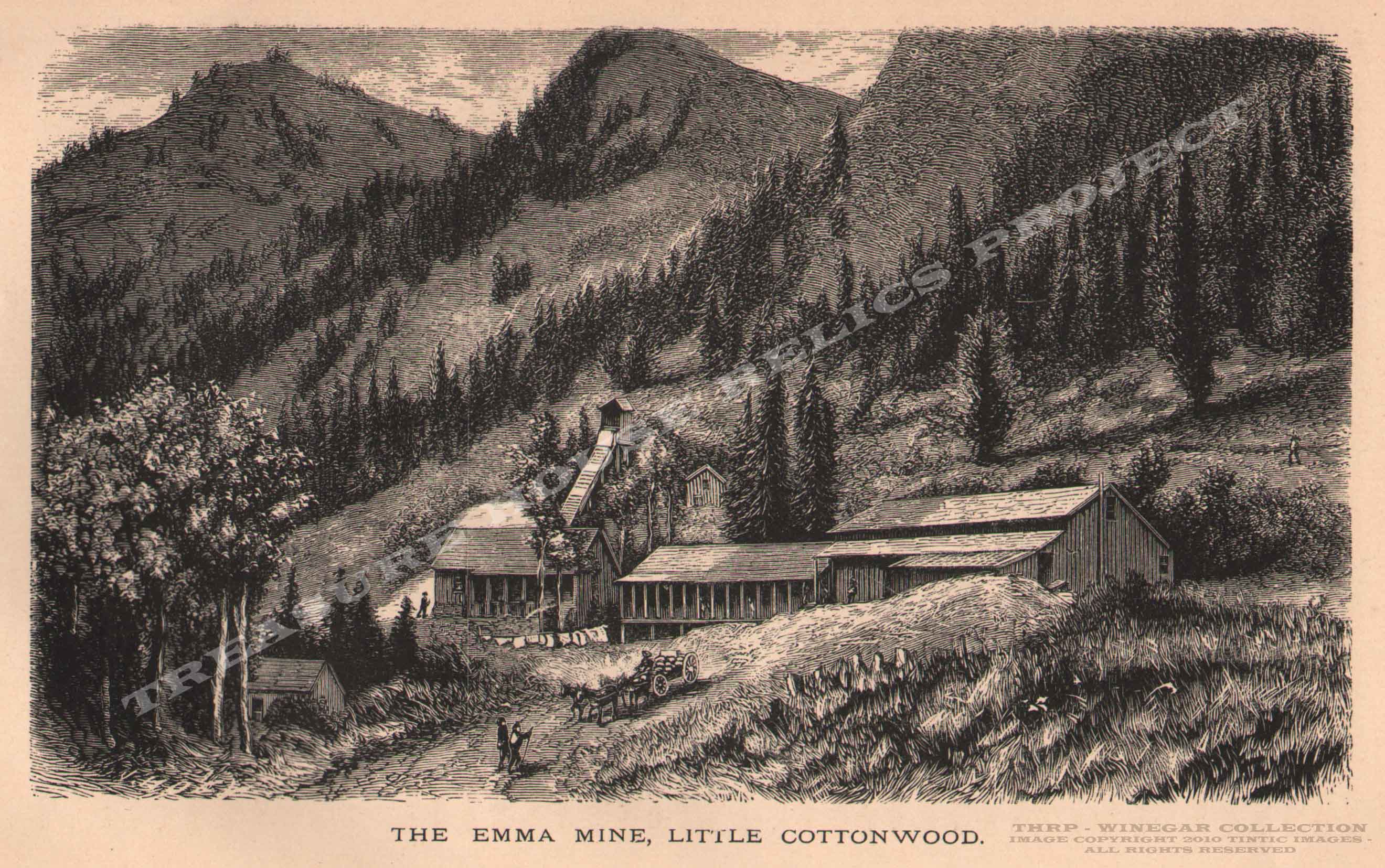History of Mining in Utah
The
beginning... Mining
in some form or another has taken place in every one of Utah's 29
counties. An alphabet soup of rocks and minerals have been mined from the state's land, some measured in ounces, others in
tons. Common to precious, the total value of material extracted counts at over a billion dollars, and continues.

Legends
tell us that the Indians and later the Spanish were the first to "mine" the lands of what is now Utah. While there is a great deal of evidence to support
these legends, the first recorded mining was conducted in 1847 by early Mormon pioneers, quarrying stone for buildings, coal
for heat, iron for tools, and lead for bullets. All "practical" items to help in settling the land. Land that was then a part of Mexico,
but envisioned as the "State of Deseret" (Shown below) by Mormon
Prophet and pioneer leader Brigham Young. (Shown at right)
Just a year later, the land would become a part of the
United States as a result of the Mexican Cession of 1848. The proposed State of Deseret would be reduced in size and eventually
become the Utah Territory in 1850. And what of mining? Though numerous locations were known to the early Mormon
pioneers, it is no secret that mining precious metals for profit was discouraged by Brigham Young. He felt it would distract
the saints from growing crops needed to sustain the settlements, draw men away from "needed" mining operations, and too, that it would bring non-Mormons
to the region. For the most part, his directions were followed. All that would change in October of 1862. At the height of the Civil War, Colonel Partick E. Connor (Shown below at
right c.1860's) with his California and Nevada Volunteers was ordered to Utah Territory. Charged with two tasks;
protect the Overland mail & stage lines, and keep an eye on the Mormons. It was no secret that Connor disliked the Latter-Day
Saints, especially President Young. He believed that Young had to much influence over the territory, the people who lived
there, and the way that things were done. He also believed he could do something about it!
Many of the soldiers
under Connor's command were experienced prospectors and miners. Connor theorized if precious metals could be found in large
enough quantities, it would bring thousands of non-Mormons to the region and Young's control would be broken. With that as
his goal, he granted leaves and issued duty assignments with just such encouragements. Sending forth small armies of soldier/prospectors
to search the nearby mountains for silver and gold. They found both. Bingham Canyon is where the first claims were staked, but it was not
long before finds near Stockton in Rush Valley, at East Canyon in the Oquirrh Mountains, and riches of Little Cottonwood Canyon
in the Wasatch Mountains were making news. And if they didn't make enough news on their own, Connor had a plan for that as
well. The Union Vedette, a small post newspaper started by Connor, in part, to provide news of the outside world to his soldiers.
But, more so, to promote the riches of Utah; to invite any and all comers to do just that! It worked, the prospectors and miners accepted that invitation. Small numbers at first,
but with the completion of the railroad in 1869, the trickle became a flood. Where before, with Connor and his men, there
were hundreds prospecting the nooks and crannies of Utah, now there were thousands. Search they did, and find they did! Thousands
of claims were staked, dozens of Mining Districts were formed, and the business of mining in Utah was here to stay. It is estimated that more than 10,000 claims were filed in those early years. Of those, less
than 1% would ever pay dividends. Less than half of those would pay dividends on a regular basis. Loosers outnumbered winners
by more than 100 to 1. Even when they beat the odds, and struck it rich, it didn't always turn out the way it was supposed
to. For proof of that, you need only say one word, "EMMA".

|
| EMMA MINE DUMP c.1870's - C.R. Savage Photo |
It is the most famous, and most
infamous mine in all of Utah History. The Emma Mine (shown above - c.1870's) in Little
Cottonwood Canyon just above the town of Alta. Famous because eager British investors paid some $5,000,000 dollars for it.
Infamous, when a short time later the vein was lost, and those same, now furious investors, claimed "Swindle!".
The British Government became involved. The U.S. Government became involved. The accusations back and forth were bitter and
stinging. Before it was over, the U.S and Britian had nearly gone to war over it! A rich little hole in the ground that maybe
wasn't so rich. Prior to the
Emma scandal, British investment in Utah mining operations had been on the rise. After the scandal, it stopped, almost completely.
Investor money was hard to come by except for a very few very well known properties. This would hinder mining development
in Utah for decades to come. Local men knew what was here, and for the most part, it was local men and savvy American investors
who would revive the industry and who would make millions. When all was said and done, the ups and downs, profits and the panics, the successes and
the failures, Utah had found success. Between 1865 and 1917, a little over 50 years, one report compiled for the Salt Lake
Mining Review listed total production value for the State of Utah at over 800 million dollars! The bulk of that value from
the Bingham (West Mountain) District, the combined Park City Districts, and the Tintic District.
Along with mines, mills and smelters dotted the state. (Chicago
Smelter near Stockton, Utah - shown at right - c.1870's) Some small, some large,
but all with the same purpose, process the mineral wealth being drawn from the land. A number of sites had their own crushing
mills, concentrating mills, or custom treatment mills. These mills were operated as long as it was economical to do so. Once the railroads began expanding in the state, transportation costs
dropped. Milling and smelting sites consolidated, and over time, Salt Lake County became the center for milling and smelting
not only in Utah but the intermountain west. That was the beginning... as is this history, the beginning of this websites
goal, to educate and inform about the story that is Utah's early hard rock mining story. In these pages, I hope to share the history of Utah mining in words
and images. To go well beyond the typical history books, and create an accurate on-line resource that is second to none. Emma, Ontario, Silver King, Daly, Utah Copper, Ophir Hill, & Mammoth.
Those are some of the famous mines you know. But what of the Tiger, Zella, Otsego, Galena Hill, Evergreen, Golden Star &
Monitor. How much do you know about them? Alta, Park City, Eureka, Mammoth, Bingham, Frisco & Silver Reef. Those are some of the famous towns you also probably
know. But what of Forrest City, Pittsburg Camp, Hangtown, Modoc City, Shauntie, Priesthood Camp, Mormon Camp, Jefferson City
& Michigan City? Those and hundreds of other boom camps and mining sites with names that you don't know, they were found, named,
lived in, and then, more often than not, simply abandoned. What are their stories? The obscure are just as interesting as the famous. They
are all a part of early mining in Utah, and they will all be a part of this site. I hope you have fun exploring and learning something
new! I know I do!
|
|